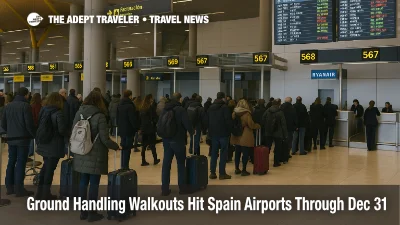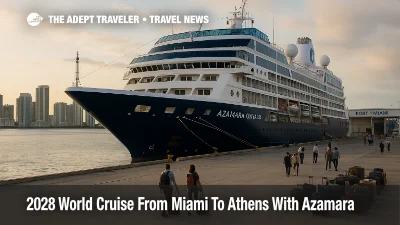Valencia, Spain

Travel to Valencia, Spain and discover a city where tradition and modernity seamlessly blend to create an unforgettable experience that awaits every traveler. Nestled along the southeastern coast of Spain, Valencia boasts a vibrant cultural heritage, breathtaking architecture, and a delectable culinary scene. When you travel to Valencia, you'll be greeted by the awe-inspiring City of Arts and Sciences, an architectural masterpiece housing a planetarium, an oceanarium, and an interactive museum. Lose yourself in the historic charm of the Barrio del Carmen, with its narrow cobbled streets and ancient buildings that tell tales of Valencia’s rich past. Explore the bustling Mercado Central, one of the largest markets in Europe, where you can taste local delicacies and fresh produce—do not miss the opportunity to try the famously refreshing drink, horchata, made from tiger nuts. Valencia, Spain also offers sun-seekers pristine, golden beaches with the Mediterranean Sea’s inviting waters just minutes away from the city center. Art lovers will revel in the array of museums and galleries, including the IVAM and the Museo de Bellas Artes. The annual Las Fallas festival is a must-experience, showcasing spectacular pyrotechnics, elaborate papier-mâché monuments, and vibrant parades. For nature enthusiasts, the Albufera Natural Park provides a serene escape with its sprawling lagoon and lush rice paddies, perfect for a tranquil boat ride or a scenic bike tour. Travel to Valencia for its impressive culinary delights where traditional Spanish paella was born, and relish in dishes that reflect the city’s love for fresh, local ingredients. With its friendly locals, enriching history, and an atmosphere that buzzes with life, Valencia, Spain is a top destination that promises to captivate and inspire anyone who visits.
The History of Valencia, Spain
Valencia, Spain, offers a rich tapestry of history that beckons travelers to explore its ancient roots and vibrant cultural evolution. As you travel to Valencia, you will step into a city that has seen a myriad of civilizations, each leaving an indelible mark on its landscape and heritage. Founded by the Romans in 138 BCE, Valencia began as a colony named "Valentia Edetanorum." The city's strategic coastal position made it a coveted asset for various empires, including the Visigoths and later the Moors, who ruled the region for over 500 years. This blend of influences has created a unique fusion of architectural and cultural elements that can be witnessed throughout the city's historic center.
One cannot travel to Valencia without witnessing the grandeur of its medieval architecture. The Torres de Serranos and Torres de Quart are exceptional examples of the city's fortified history. These imposing gates once formed part of the ancient wall that protected Valencia from invaders. As you wander through the Old Town, you'll find the stunning Valencia Cathedral, a masterpiece that began its life as a mosque during the Moorish occupation before becoming a beautiful Gothic cathedral. Inside, the Holy Grail Chapel is reputed to house the actual Holy Grail, adding a touch of mystique to your travel to Valencia, Spain.
The influence of the Silk Road is another facet of Valencia's fascinating history. In the 15th century, Valencia emerged as a significant European trading hub, with its La Lonja de la Seda (Silk Exchange) becoming a focal point of commerce and wealth. This UNESCO World Heritage site is one of the finest examples of Gothic civil architecture in Europe. As you travel to Valencia, the grandiose pillars of the main hall and the intricately carved ceilings will transport you back to an era when silk merchants and traders thrived here, contributing to the prosperity and cultural richness of Valencia, Spain.
In the modern age, Valencia's history continues to evolve while preserving its unique heritage. The city’s historical narrative is juxtaposed with contemporary landmarks like the City of Arts and Sciences, designed by the renowned architect Santiago Calatrava. This modern marvel adds a striking contrast to the city’s ancient roots and signifies Valencia's forward-thinking spirit. However, it is the mingling of Valencia’s old and new that creates an unforgettable travel experience. Each street, plaza, and market in Valencia, Spain, tells a story of resilience, innovation, and cultural amalgamation, inviting visitors to dive deep into its storied past while enjoying the vibrant present.
The Culture of Valencia, Spain
Valencia, Spain, a city where history and modernity blend seamlessly, offers a rich tapestry of culture that promises an unforgettable travel experience. From its stunning architecture to its vibrant festivals, Valencia is a feast for the senses, inviting travelers to immerse themselves in its lively atmosphere. Traveling to Valencia means stepping into a world where every corner unravels a story, deeply rooted in traditions yet effortlessly contemporary.
The Heartbeat of Valencia
The people of Valencia, known as Valencians, are warm and welcoming, making any travel to Valencia an enriching experience. Their passion for life is evident in the way they celebrate festivals, especially Las Fallas, a UNESCO-recognized festival that lights up the city every March. This tradition, filled with elaborate sculptures, fireworks, and street parties, is a vibrant manifestation of the Valencian spirit. The city's residents, proud of their heritage, are always eager to share their customs, ensuring that visitors don’t just see Valencia, but feel it.
Culinary Delights
Valencia, Spain, is the birthplace of the world-renowned paella, a culinary masterpiece that attracts food enthusiasts from around the globe. While traveling to Valencia, indulging in authentic paella along the picturesque beachside or at traditional local eateries is a must. However, Valencian cuisine offers more than just paella. The city's food scene is a delightful blend of Mediterranean flavors, with dishes like “fideuà,” “esgarraet,” and “horchata” bursting with local ingredients and love. Every meal in Valencia is an exploration of its rich cultural heritage, ensuring that every bite tells a story.
A Symphony of Art and Architecture
Architecture in Valencia is a captivating mix of the old and new, epitomizing the city's commitment to preserving its historical roots while embracing innovation. The gothic architecture of the Valencia Cathedral and the futuristic designs of the City of Arts and Sciences are perfect examples of this harmonious blend. Walking through Valencia's streets, travelers will encounter breathtaking buildings, quaint plazas, and stunning murals that narrate the city's artistic journey. For art lovers, the numerous museums and galleries provide a deeper delve into Valencian art and history.
Nature and Relaxation
Travel to Valencia, Spain, also means enjoying its extensive natural beauty. The city boasts beautiful parks, like the Turia Gardens, which stretch for nine kilometers and offer a green escape in the urban landscape. The Albufera Natural Park, just a short drive from the city center, is a serene sanctuary where visitors can experience the region's natural wetlands, offering boat rides and a chance to witness breathtaking sunsets. For those who love the sea, Valencia's pristine beaches are perfect for relaxation and water sports, making every day an adventure.
In essence, Valencia, Spain, is a destination that offers an incredible variety of cultural experiences. With its vibrant festivals, delicious cuisine, stunning architecture, and natural beauty, this city promises a rich and fulfilling travel experience, inviting all who visit to become part of its living tapestry. Travel to Valencia and discover why it remains one of Spain's most cherished cultural gems.
The Food of Valencia, Spain
When you travel to Valencia, Spain, you're embarking on an unforgettable culinary journey that combines rich history, vibrant culture, and mouth-watering flavors. Valencia is renowned for its gastronomic diversity, which blends traditional Spanish cuisine with innovative modern twists. As the birthplace of the world-famous paella, Valencia offers an array of culinary delights that will appeal to any food enthusiast. Whether you're a passionate gastronome, an adventurous foodie, or simply someone who appreciates a good meal, Valencia, Spain promises an unparalleled dining experience.
Paella: The Heart of Valencian Cuisine
The iconic dish you must try when you travel to Valencia is, of course, paella. This sumptuous rice dish, traditionally cooked over an open flame in a wide, shallow pan, varies with rich flavors and locally sourced ingredients. Valencian paella typically includes chicken, rabbit, and a mix of vegetables like tomatoes, green beans, and garrofó (a large, flat bean native to Valencia). Some variations also incorporate seafood, filling the dish with the aroma and taste of the Mediterranean. Pair this flavorful experience with a glass of locally produced wine or a refreshing horchata, and your taste buds will thank you
Tapas: A Festival of Flavors
Beyond paella, travelers to Valencia, Spain can indulge in a vast array of tapas. These small, shareable plates capture the essence of Spanish cuisine, with every bite telling a story. Explore vibrant tapas bars throughout the city where you can savor dishes like patatas bravas, shrimp in garlic oil, and Iberian ham. Many bars feature a rotating menu, offering the chance to sample different local specialties with each visit. The atmosphere is equally part of the experience, with the lively chatter of locals providing the perfect backdrop to the tantalizing flavors of Valencia.
Seafood: The Bounty of the Mediterranean
The proximity of Valencia to the Mediterranean Sea ensures a fresh and abundant selection of seafood. Travel to Valencia and you'll find the daily catches transformed into delectable dishes such as arroz a banda, a seafood rice dish cooked in fish broth, and suquet de peix, a traditional fish stew. The central market, Mercado Central, is a must-visit for any seafood lover. Here, you can witness the daily hustle of local vendors selling the freshest fish, octopus, squid, and shellfish, which can be enjoyed in various local restaurants.
Sweet Temptations: Valencia's Desserts
To end your culinary journey on a sweet note, Valencia, Spain offers a delightful selection of desserts. As you travel through the city's cafes and bakeries, you'll find treats like buñuelos, deep-fried dough balls dusted with sugar, and roscón de reyes, a festive sweet bread traditionally enjoyed during the holiday season. Don't forget to try turrón, a nougat confection usually made of honey, sugar, egg whites, and almonds. Each dessert showcases Valencia's ability to turn simple ingredients into culinary masterpieces, leaving you with a lasting impression of the city's sweet traditions.
What to See and Do in Valencia, Spain
Travel enthusiasts often have Valencia, Spain on their must-visit list, and it's easy to see why. This captivating city offers a unique blend of history, art, and culinary delights, making it an essential destination. From exploring ancient markets to soaking in modern architectural wonders, here are ten detailed and immersive experiences you should embark on when you travel to Valencia.
1. Wander Around the Ciudad de las Artes y las Ciencias
The Ciudad de las Artes y las Ciencias in Valencia, Spain is a stunning architectural marvel. This expansive complex houses a myriad of futuristic buildings, including an opera house, a science museum, and an IMAX cinema. Stroll along the turquoise water pools and snap photos of the avant-garde structures. Every corner of this sprawling campus offers a blend of educational and recreational wonders, making it a favorite among tourists who travel to Valencia.
2. Visit the Central Market (Mercado Central)
The Central Market is an iconic Valencia attraction. This vibrant market is housed in a beautiful modernist building adorned with intricate mosaics. Here, you'll find a plethora of fresh produce, seafood, and traditional Spanish delicacies. Make sure to indulge in some local tapas and purchase artisanal products such as cheese, cured meats, and pastries. It's an essential stop to experience the bustling life and flavors when you travel to Valencia, Spain.
3. Explore the Valencia Cathedral and El Miguelete
No trip to Valencia is complete without visiting the historic Valencia Cathedral. This magnificent cathedral boasts a mix of Gothic, Romanesque, and Baroque architectural styles. Climb the 207 steps of El Miguelete, the cathedral’s bell tower, to enjoy panoramic views of the city, country. The cathedral is also home to the Holy Grail, revered as the cup of Christ, adding to its spiritual and historical significance.
4. Discover Valencia’s Turia Gardens
The Turia Gardens, or Jardín del Turia, is an urban oasis that spans over nine kilometers. This beautifully landscaped park was created from a diverted riverbed and offers lush gardens, sports facilities, and open spaces for relaxation. Rent a bike or take a leisurely stroll to absorb the scenic beauty and tranquility of this green gem in the heart of Valencia, Spain.
5. Experience the Oceanografic Aquarium
The Oceanografic Aquarium in Valencia is the largest of its kind in Europe. Located within the Ciudad de las Artes y las Ciencias, this impressive aquarium features a vast array of marine habitats, from the Arctic to the Red Sea. Visitors can marvel at dolphins, jellyfish, and even sharks. Don't miss the underwater tunnel that provides a 360-degree view of various aquatic creatures swimming overhead. It's a mesmerizing experience, especially for families traveling to Valencia, Spain.
6. Stroll Through the Barrio del Carmen
The Barrio del Carmen is a charming historic neighborhood in Valencia. Characterized by its narrow streets, lively squares, and bohemian vibe, this district is filled with graffiti art, boutique shops, and cozy cafes. Visit the medieval gates, Torres de Quart and Torres de Serranos, to imagine the city's ancient fortifications. It's a vibrant area perfect for evening strolls and experiencing the local nightlife.
7. Taste the Authentic Valencian Paella
When you travel to Valencia, Spain, tasting the authentic Valencian Paella is a culinary imperative. This world-renowned dish originated in Valencia and is traditionally prepared with chicken, rabbit, green beans, and saffron-infused rice cooked in a wide, shallow pan. Head to a reputable local restaurant or seaside eatery in the Albufera Natural Reserve for the most authentic experience.
8. Tour the Silk Exchange (La Lonja de la Seda)
La Lonja de la Seda is a UNESCO World Heritage Site and a testament to Valencia's rich mercantile history. This Gothic building dates back to the 15th century and was used for trading silk and other goods. Admire the ornate architecture, including the twisting columns in the main hall and the intricately carved ceilings. It offers a glimpse into the bustling trade life that once dominated this city, country.
9. Relax on Malvarrosa Beach
A visit to Valencia, Spain is incomplete without spending time at Malvarrosa Beach. This expansive and sandy beach is ideal for soaking up the Spanish sun or enjoying a refreshing swim in the Mediterranean. The beachfront promenade is lined with restaurants and cafes where you can savor local seafood dishes while enjoying the sea views. It's a perfect spot to unwind after a day of sightseeing.
10. Visit the Albufera Natural Park
The Albufera Natural Park is a serene escape just a short drive south from Valencia, Spain. This picturesque wetland reserve is home to a large freshwater lagoon and a diverse array of wildlife. Take a boat ride to explore the lagoon, enjoy bird watching, or hike the trails that meander through rice fields and lush landscapes. The park is also famed for its sunsets, which cast a magical glow over the water, creating picture-perfect moments.
These experiences are just the tip of the iceberg when it comes to what you can do when you travel to Valencia. This dynamic city, country brims with rich history, cultural treasures, and mouthwatering cuisine, ensuring that every traveler leaves with unforgettable memories.
Why You Should Travel to Valencia, Spain
Valencia, the third-largest city in Spain, offers an enchanting blend of modernity and tradition that attracts travelers from around the globe. One of the prime reasons tourists love to travel to Valencia is its stunning architecture. Valencia is a city where centuries-old Gothic structures coexist harmoniously with avant-garde buildings. The City of Arts and Sciences, a magnificent cultural and architectural complex, showcases contemporary design and houses an opera, a science museum, and an IMAX cinema. In contrast, the old town, with its medieval cathedrals and historic plazas, provides a glimpse into the rich history of the region.
Apart from architectural wonders, travel to Valencia promises a culinary adventure unlike any other. Known as the birthplace of paella, Valencia, Spain is a gastronomic haven for food enthusiasts. The city's vibrant markets, such as Mercado Central, offer fresh produce and traditional delicacies. Travelers can enjoy not only the iconic paella but also horchata, a refreshing tiger nut drink, and a myriad of seafood dishes. The culinary landscape in Valencia is diverse, catering to all palates and promising an unforgettable food journey.
Naturally blessed with beautiful beaches and sunny weather, Valencia is a top choice for travelers seeking relaxation and outdoor activities. Malvarrosa Beach, located close to the city center, is perfect for sunbathing, swimming, and enjoying water sports. The nearby Albufera Natural Park provides a picturesque escape where visitors can indulge in boat rides, bird-watching, and stunning sunsets. With an extensive network of bike lanes, parks like Turia Gardens, and a generally warm climate, it’s no wonder tourists flock to Valencia, Spain to soak up the outdoors.
Why You Should Travel to Valencia
As someone looking to embark on an unforgettable journey, you must travel to Valencia, Spain. This city offers a perfect mix of cultural experiences, culinary delights, and coastal relaxation. Whether you are an architecture enthusiast, a foodie, or a nature lover, Valencia has something to cater to your interests. Travel to Valencia, and you will discover a city that beautifully marries its historical roots with contemporary charm, making it a captivating destination for travelers. Make Valencia your next travel destination, and experience firsthand the allure that has enchanted countless visitors.
Tips & Tricks for Traveling in Valencia, Spain
Travel to Valencia offers an unforgettable experience, as this vibrant city in Spain is a treasure trove of culture, history, and natural beauty. Whether you are planning to travel to Valencia, Spain for the first time or you are a seasoned wanderer seeking new adventures, there are always tips and tricks to enhance your journey. Here are ten invaluable suggestions that will make your travel to Valencia even better.
Choose the Right Time to Visit
Valencia, Spain has a Mediterranean climate which means mild winters and hot summers. The best times to travel to Valencia are during the spring (March to June) and fall (September to November) when the weather is pleasant without being uncomfortably hot. These months also coincide with popular local festivals like Las Fallas in March and La Tomatina in nearby Buñol in August.
Stay in the City Center
When traveling to Valencia, consider staying in the city center. The historic center, El Carmen, offers a range of accommodations from luxury hotels to budget-friendly hostels. Staying here will put you in close proximity to Valencia Cathedral, the Central Market, and other iconic attractions. Plus, you can easily explore the city by foot or public transport.
Make Use of Public Transportation
Valencia boasts an efficient public transportation system including buses, trams, and a metro. A Valencia Tourist Card allows unlimited travel on all public transport for a set number of days, which can save you money and time. Don't miss the opportunity to use bikes too, as Valencia is bike-friendly with many cycling lanes and rental options.
Visit Iconic Landmarks
No travel to Valencia is complete without visiting its renowned landmarks. Spend time at the City of Arts and Sciences, an architectural marvel encompassing a planetarium, oceanarium, and interactive museum. Also, the Valencia Cathedral and its Miguelete tower offer panoramic city views while the medieval Silk Exchange (La Lonja) is a UNESCO World Heritage Site worth exploring.
Indulge in Local Cuisine
Valencia, Spain is the birthplace of paella. Make sure to try the authentic Valencian Paella made with chicken, rabbit, and local beans. Visit the Central Market to sample fresh produce, seafood, and other local delicacies. Don’t forget to try horchata, a traditional drink made from tiger nuts, at one of Valencia’s many horchaterías.
Experience Local Festivals
When planning your travel to Valencia, try to coincide your trip with one of the city's famous festivals. Las Fallas, celebrated in March, involves elaborate paper-mâché figures, fireworks, and street parties. Another must-see is La Tomatina in nearby Buñol, where participants engage in a massive tomato fight. These festivals provide a unique cultural experience.
Explore the Turia Gardens
The Turia Gardens are a must-visit when traveling to Valencia. This sprawling park was created from a diverted riverbed and offers lush greenery, bike paths, playgrounds, and sports facilities. Spend a relaxing afternoon here or use it as a scenic route to walk from the City of Arts and Sciences to the historic center.
Take a Day Trip to Albufera Natural Park
Albufera Natural Park, located just a short drive from Valencia, Spain, provides a serene escape from the city. The park is home to Albufera Lake, rice paddies, and a variety of bird species. Enjoy a boat ride on the lake or sample a traditional meal at one of the local restaurants. It's an excellent way to connect with nature.
Enjoy Valencia’s Beaches
Valencia has some beautiful beaches that are easily accessible from the city. Malvarrosa Beach is the most popular, offering golden sands, restaurants, and water sports. For a quieter experience, check out Patacona Beach. Spending a day at the beach is a perfect way to relax and enjoy the Mediterranean Sea.
Shop Local at the Ruzafa Market
Ruzafa is a trendy neighborhood known for its vibrant atmosphere and cultural diversity. The Ruzafa Market is ideal for buying local products, handmade crafts, and fresh food. It's also a great place to immerse yourself in the daily life of Valencia’s residents. The area is filled with cafes, shops, and nightlife options, making it perfect for an afternoon or evening outing.
By following these tips, your travel to Valencia, Spain is sure to be an enriching and enjoyable experience. Whether you are drawn to its history, culture, or natural beauty, Valencia has something for everyone. From exploring iconic landmarks to indulging in delectable local cuisine, the city promises a memorable journey.
Other Places You Might Like
If you are a fan of Valencia, Spain, you are probably enchanted by its rich history, vibrant cultural scene, and beautiful Mediterranean beaches. Exploring similar destinations can offer you a new depth of experiences while capturing some of the same essence that makes Valencia so special.
Seville, Spain
Seville, Spain - Another gem in the Andalusian region, Seville offers a captivating mix of Moorish architecture, Flamenco music, and delightful tapas. Famous for its Gothic Seville Cathedral, the largest in the world, and the Alcázar of Seville, this city offers a blend of historical grandeur and lively street life. If you appreciate Valencia's vibrant Spanish culture and historical significance, traveling to Seville is a must.
Barcelona, Spain
Barcelona, Spain - For those who love Valenica's picturesque Mediterranean coastline and artistic landmarks, Barcelona, with its blend of modernist architecture by Antoni Gaudí, offers equally enchanting experiences. From the La Sagrada Familia to Park Güell, Barcelona is a testament to artistic innovation. Additionally, the city's beaches and bustling Las Ramblas street offer vibrant urban life reminiscent of Valencia's dynamic atmosphere.
Porto, Portugal
Porto, Portugal - Porto, with its narrow cobbled streets and scenic riverside views, is perfect for travelers who love Valencia's blend of old-world charm and lively modern culture. The Ribeira district, a UNESCO World Heritage site, boasts medieval influences, while the Douro River offers picturesque views and boat rides. Porto’s wine culture, particularly its famous Port wine, makes it an idyllic destination for those who enjoy the culinary delights of Valencia, Spain.
Athens, Greece
Athens, Greece - Those captivated by the historical richness of Valencia will find Athens, the cradle of Western civilization, incredibly rewarding. From the Parthenon to the Ancient Agora, Athens offers an unparalleled glimpse into the past. Similar to how Valencia, Spain, weaves Roman and modern influences, Athens balances ancient wonders with a cosmopolitan vibe. The city’s tavernas and café culture will also resonate with those who enjoy the social dining experiences found in Valencia.
Lisbon, Portugal
Lisbon, Portugal - Lisbon’s blend of traditional and contemporary elements makes it a fabulous destination for fans of Valencia, Spain. The hilly, coastal city offers stunning viewpoints from the Alfama district, rich with fado music, to the modern architecture seen in the Parque das Nações. Lisbon’s vibrant street art and historic tram rides create a colorful and engaging environment reminiscent of Valencia's diverse and lively urban fabric.
Palermo, Italy
Palermo, Italy - If Valencia’s amalgamation of different cultures fascinates you, Palermo will not disappoint. This Sicilian city boasts a blend of Norman, Arab, and Italian influences, visible in its architecture, cuisine, and cultural traditions. The bustling Vucciria Market offers an experience similar to Valencia's Central Market, and the city’s coastal setting provides beautiful seaside views to rival any found in Valencia, Spain.
Marseille, France
Marseille, France - As a city by the Mediterranean, Marseille shares Valencia’s love for the sea. The oldest city in France, Marseille offers a diverse cultural scene and historical sites like the Basilique Notre-Dame de la Garde. Its vibrant Vieux-Port (Old Port) area and delicious seafood delicacies echo the maritime culture you enjoyed when you traveled to Valencia. Additionally, Marseille's contemporary art scene and cosmopolitan atmosphere provide a dynamic experience similar to Valencia’s.
Whether you are drawn to Valencia, Spain, for its beautiful beaches, rich history, or vibrant culture, these cities offer a variety of experiences that capture the same spirit. Traveling to these destinations will undoubtedly deepen your appreciation for Mediterranean beauty and cultural diversity, ensuring that your love for Valencia only continues to grow.
London Airport Strikes Disrupt Christmas Flights

MSC Magnifica World Cruise 2028 Booking Details

A&K - Crystal 2027 Cruise Dates for Europe, New York

Spain Airbnb Fine Hits Tourist Rental Listings

Tarifa Tangier Ferries Canceled in Gibraltar Winds

Azul Handling Strike Spain Airports Through Dec 31

Barbados And Spain Lead 2026 Villa Trends

Spain Airport Handling Strike Days Through December 31

Schengen Internal Border Checks Widespread In Late 2025

Europe Air Traffic Control Delays Worsen, Add Buffers

Ground Handling Walkouts Hit Spain Airports Through Dec 31

Portugal General Strike Cuts Flights And Trains Dec 11 2025

Europe December Strikes Hit Holiday Flights And Trains

Spain Doctors Strike Cuts Hospital Care Dec 9 12

Maltese Falcon Med Caribbean Cruises December 2025

Spain Flu Surge Brings Hospital Mask Rules

Europe 2025 Travel Rules Tighten Borders And Costs

2028 World Cruise From Miami To Athens With Azamara

Spain Iryo Rail Strike To Hit Madrid Routes Dec 5 8

New Melbourne Doha Flights Expand Europe Options

2027 Mediterranean Season Adds Egypt Yacht Voyages

Roam 2026 Tours Open For Bookings In Mexico, Europe

World Cruise Dubai To Barcelona 2029 Route Announced

Spain Baggage Strikes Slow Airport Hubs For Ryanair

Spain High Speed Rail Strike Cuts Iryo Services

